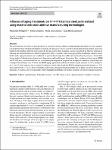Item Infomation
Full metadata record
| DC Field | Value | Language |
|---|---|---|
| dc.contributor.author | Alessandro, Pellegrini | - |
| dc.contributor.author | Fulvio, Lavecchia | - |
| dc.contributor.author | Maria Grazia, Guerra | - |
| dc.date.accessioned | 2023-04-17T07:28:37Z | - |
| dc.date.available | 2023-04-17T07:28:37Z | - |
| dc.date.issued | 2023 | - |
| dc.identifier.uri | https://link.springer.com/article/10.1007/s00170-023-11136-3 | - |
| dc.identifier.uri | https://dlib.phenikaa-uni.edu.vn/handle/PNK/7995 | - |
| dc.description | CC BY | vi |
| dc.description.abstract | The most relevant criticalities of parts produced by material extrusion additive manufacturing technologies are lower mechanical properties than standard material performances, the presence of pores caused by the manufacturing method, and issues related to the interface between layers and rods. In this context, heat treatments can be considered an effective solution for tailoring the material behavior to different application fields, especially when using precipitation hardening stainless steels. In this work, aging treatments were conducted on parts realized using three different extrusion-based processes: Atomic Diffusion Additive Manufacturing, bound metal deposition, and fused filament fabrication. | vi |
| dc.language.iso | en | vi |
| dc.publisher | Springer | vi |
| dc.subject | 17–4 PH stainless steel parts | vi |
| dc.subject | extrusion additive manufacturing technologies | vi |
| dc.title | Influence of aging treatments on 17–4 PH stainless steel parts realized using material extrusion additive manufacturing technologies | vi |
| dc.type | Book | vi |
| Appears in Collections | ||
| OER - Kỹ thuật điện; Điện tử - Viễn thông | ||
Files in This Item:

